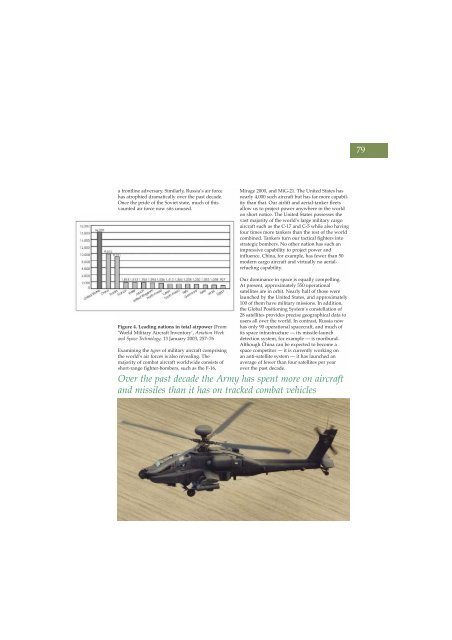Volume 6 No 4 - Royal Air Force Centre for Air Power Studies
Volume 6 No 4 - Royal Air Force Centre for Air Power Studies
Volume 6 No 4 - Royal Air Force Centre for Air Power Studies
You also want an ePaper? Increase the reach of your titles
YUMPU automatically turns print PDFs into web optimized ePapers that Google loves.
79<br />
a frontline adversary. Similarly, Russia’s air <strong>for</strong>ce<br />
has atrophied dramatically over the past decade.<br />
Once the pride of the Soviet state, much of this<br />
vaunted air <strong>for</strong>ce now sits unused.<br />
Mirage 2000, and MiG-21. The United States has<br />
nearly 4,000 such aircraft but has far more capability<br />
than that. Our airlift and aerial-tanker fleets<br />
allow us to project power anywhere in the world<br />
on short notice. The United States possesses the<br />
vast majority of the world’s large military cargo<br />
aircraft such as the C-17 and C-5 while also having<br />
four times more tankers than the rest of the world<br />
combined. Tankers turn our tactical fighters into<br />
strategic bombers. <strong>No</strong> other nation has such an<br />
impressive capability to project power and<br />
influence. China, <strong>for</strong> example, has fewer than 50<br />
modern cargo aircraft and virtually no aerialrefueling<br />
capability.<br />
Figure 4. Leading nations in total airpower (From<br />
‘World Military <strong>Air</strong>craft Inventory’, Aviation Week<br />
and Space Technology, 13 January 2003, 257–76<br />
Examining the types of military aircraft comprising<br />
the world’s air <strong>for</strong>ces is also revealing. The<br />
majority of combat aircraft worldwide consists of<br />
short-range fighter-bombers, such as the F-16,<br />
Our dominance in space is equally compelling.<br />
At present, approximately 550 operational<br />
satellites are in orbit. Nearly half of those were<br />
launched by the United States, and approximately<br />
100 of them have military missions. In addition,<br />
the Global Positioning System’s constellation of<br />
28 satellites provides precise geographical data to<br />
users all over the world. In contrast, Russia now<br />
has only 90 operational spacecraft, and much of<br />
its space infrastructure — its missile-launch<br />
detection system, <strong>for</strong> example — is moribund.<br />
Although China can be expected to become a<br />
space competitor — it is currently working on<br />
an anti-satellite system — it has launched an<br />
average of fewer than four satellites per year<br />
over the past decade.<br />
Over the past decade the Army has spent more on aircraft<br />
and missiles than it has on tracked combat vehicles
















